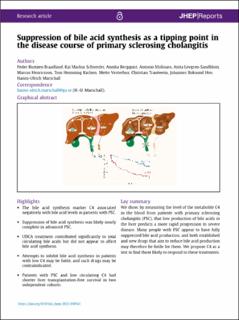Suppression of bile acid synthesis as a tipping point in the disease course of primary sclerosing cholangitis
Braadland, Peder Rustøen; Schneider, Kai Markus; Bergquist, Annika; Molinaro, Antonio; Lövgren-Sandblom, Anita; Henricsson, Marcus; Karlsen, Tom Hemming; Vesterhus, Mette Nåmdal; Trautwein, Christian; Hov, Johannes Espolin Roksund; Marschall, Hanns-Ulrich
Journal article, Peer reviewed
Published version

Åpne
Permanent lenke
https://hdl.handle.net/11250/3029729Utgivelsesdato
2022Metadata
Vis full innførselSamlinger
- Department of Clinical Science [2318]
- Registrations from Cristin [9791]
Sammendrag
Background & Aims: Farnesoid X receptor (FXR) agonists and fibroblast growth factor 19 (FGF19) analogues suppress bile acid synthesis and are being investigated for their potential therapeutic efficacy in cholestatic liver diseases. We investigated whether bile acid synthesis associated with outcomes in 2 independent populations of people with primary sclerosing cholangitis (PSC) not receiving such therapy.
Methods: Concentrations of individual bile acids and 7α-hydroxy-4-cholesten-3-one (C4) were measured in blood samples from 330 patients with PSC attending tertiary care hospitals in the discovery and validation cohorts and from 100 healthy donors. We used a predefined multivariable Cox proportional hazards model to evaluate the prognostic value of C4 to predict liver transplantation-free survival and evaluated its performance in the validation cohort.
Results: The bile acid synthesis marker C4 was negatively associated with total bile acids. Patients with fully suppressed bile acid synthesis had strongly elevated total bile acids and short liver transplantation-free survival. In multivariable models, a 50% reduction in C4 corresponded to increased hazards for liver transplantation or death in both the discovery (adjusted hazard ratio [HR] = 1.24, 95% CI 1.06–1.43) and validation (adjusted HR = 1.23, 95% CI 1.03–1.47) cohorts. Adding C4 to established risk scores added value to predict future events, and predicted survival probabilities were well calibrated externally. There was no discernible impact of ursodeoxycholic acid treatment on bile acid synthesis.
Conclusions: Bile acid accumulation-associated suppression of bile acid synthesis was apparent in patients with advanced PSC and associated with reduced transplantation-free survival. In a subset of the patients, bile acid synthesis was likely suppressed beyond a tipping point at which any further pharmacological suppression may be futile. Implications for patient stratification and inclusion criteria for clinical trials in PSC warrant further investigation.
